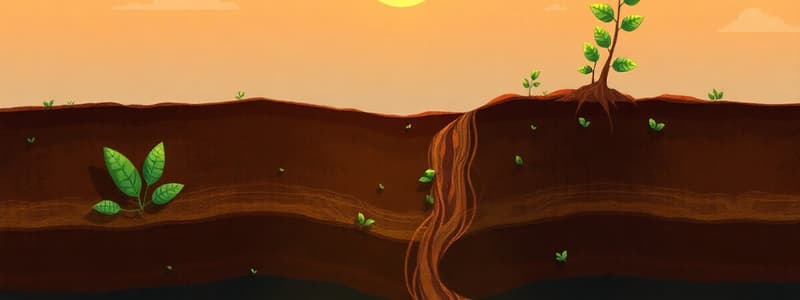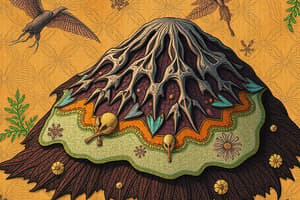Podcast
Questions and Answers
What are the two primary types of ecosystems discussed?
What are the two primary types of ecosystems discussed?
- Wetlands and Rock deserts
- Savannas and Tropical rainforests
- Tall grass prairie and Deciduous hardwood forest (correct)
- Alpine tundra and Boreal forest
What characteristic of prairie soils is highlighted?
What characteristic of prairie soils is highlighted?
- They have a dark and deep surface layer (correct)
- They contain waterlogged conditions
- They have a high salinity level
- They have a thin and pale surface layer
What contributes significantly to physical weathering in rocks?
What contributes significantly to physical weathering in rocks?
- Freezing and thawing cycles (correct)
- Conservation of minerals
- Chemical reactions with minerals
- Exposure to sunlight
Which option best describes the effect of chemical weathering?
Which option best describes the effect of chemical weathering?
How is soil texture defined?
How is soil texture defined?
Which type of weathering involves changes to the chemical structure of rocks?
Which type of weathering involves changes to the chemical structure of rocks?
In what climate type is Illinois classified?
In what climate type is Illinois classified?
Which of the following is NOT used to recognize soil features?
Which of the following is NOT used to recognize soil features?
What is the primary function of organic matter in soil?
What is the primary function of organic matter in soil?
Which type of water in soil is primarily unavailable to plants?
Which type of water in soil is primarily unavailable to plants?
Which component of soil accounts for approximately 25% of its total volume when dry?
Which component of soil accounts for approximately 25% of its total volume when dry?
What is the role of bacteria and fungi in soil ecosystems?
What is the role of bacteria and fungi in soil ecosystems?
Which of the following is NOT one of the basic needs that plants depend on soil to provide?
Which of the following is NOT one of the basic needs that plants depend on soil to provide?
What is the term for the process by which water moves downward in the soil after it has infiltrated?
What is the term for the process by which water moves downward in the soil after it has infiltrated?
What is meant by 'soil tilth'?
What is meant by 'soil tilth'?
What percentage of soil is typically composed of mineral matter?
What percentage of soil is typically composed of mineral matter?
What percentage of soil in Illinois is formed from loess?
What percentage of soil in Illinois is formed from loess?
Which factor does NOT influence soil formation?
Which factor does NOT influence soil formation?
What is the primary use of grazing land?
What is the primary use of grazing land?
Which type of rock does NOT categorize as a parent material for soil?
Which type of rock does NOT categorize as a parent material for soil?
What role do native vegetation play in soil formation?
What role do native vegetation play in soil formation?
Which of the following is NOT a non-agricultural use of soil?
Which of the following is NOT a non-agricultural use of soil?
Which of the following is classified as organic soil?
Which of the following is classified as organic soil?
What effect does time or weathering have on soil?
What effect does time or weathering have on soil?
Flashcards are hidden until you start studying
Study Notes
Soil
- Soil is a layer on the Earth's crust that supports plant and animal life.
- Soil provides essential resources for plant growth: oxygen, temperature, water, carbon, and nutrients.
- Soil is composed of a solid portion (50%) and pore spaces (50%).
- The solid portion consists of mineral matter (45%) and organic matter (~5%).
- Pore spaces include air (25%) and water (25%).
- Water in soil can be classified as gravitational, capillary, and hygroscopic water.
- Bacteria and fungi play a crucial role in soil by decomposing organic matter and releasing nutrients.
- Soil provides anchorage, water, oxygen, and nutrients for plant growth.
- Agriculture relies on soil for growing food, fiber, and other plants.
- Soil is used for various non-agricultural purposes, including recreation, foundations, waste disposal, and building materials.
Soil Formation
- Five factors influence soil formation: parent material, climate, living organisms, topography, and time (weathering).
- Parent material refers to the type of rock that soil is derived from, including igneous, metamorphic, and sedimentary.
- Climate significantly impacts soil formation through temperature, moisture, rainfall, freezing, thawing, wind, and sunlight.
- Living organisms, such as plants, insects, and microbes, actively influence soil formation.
- Topography, including hills and valleys, plays a role in soil formation due to differing water drainage and erosion patterns.
- Time, or weathering, refers to the age of the soil and its exposure to climatic factors.
- Parent material is formed from the disintegration and decomposition of rock.
Soil Parent Materials
- Most soils in Illinois were formed by glaciers.
- Loess, windblown soil deposited after glaciers retreated, accounts for approximately 64% of Illinois soil.
- Alluvium, recent stream deposits, makes up about 7% of Illinois soil.
- Bedrock, including shale, sandstone, and limestone, is largely buried by loess, except in extreme northwest and southern Illinois.
- Organic soils, mainly muck and peat, comprise less than 1% of Illinois soils.
Topography and Living Organisms
- Topography refers to the slope characteristics of the land.
- Living organisms in soil, including plants, insects, and microbes, have a significant impact on soil formation.
- Native vegetation, particularly tall grass prairie and deciduous hardwood forests, plays a crucial role in soil development.
Weathering
- Weathering refers to the breakdown of rock into soil.
- Physical weathering involves the breakdown of rocks through climatic factors like temperature, water, and wind.
- Chemical weathering alters the chemical makeup of rocks and breaks them down through processes like dissolution and oxidation.
Soil Features
- Soil texture refers to the coarseness or fineness of soil particles, categorized as sand, silt, and clay.
- Soil structure describes how soil particles are held together.
- Depth of horizons refers to the depth of each distinct layer within the soil profile.
- Soil color indicates the level of organic matter content, ranging from very dark to very light.
Climate in Illinois
- Illinois has a continental climate characterized by hot summers and cold winters.
Importance of Soil
- Soil plays a crucial role in supporting plant and animal life, agriculture, and various non-agricultural activities.
- Understanding soil formation, characteristics, and management practices is essential for sustainable resource management.
Studying That Suits You
Use AI to generate personalized quizzes and flashcards to suit your learning preferences.




